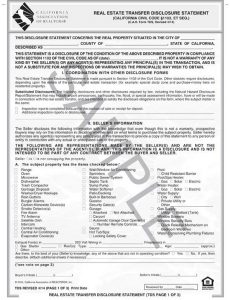The Real Estate Transfer Disclosure Statement Explained
The Real Estate Transfer Disclosure Statement
Part 1
We are excited to present part one of a two-part series about the seller property disclosure statements required when selling residential properties in California. Part one is a brief overview of the Real Estate Transfer Disclosure Statement also called the TDS.
When you sell a residential property you will be filling out the TDS. Simply stated, the Transfer Disclosure Statement gives the Seller an opportunity to disclose information about the property that would be important for the potential Buyer to know.
You, as the Seller of the property, are required to provide this document within 7 days of an accepted contract between you and the Buyer.
 What Information is Disclosed in the Transfer Disclosure Statement (TDS)
What Information is Disclosed in the Transfer Disclosure Statement (TDS)
As the property Seller, you will be asked to list what items are included with the home such as:
- Range
- Oven
- Microwave
- Trash Compactor
- Garbage Disposal
- Sprinklers
- Septic Tank
- Water Softener
- Pool and much more.
Next up on the Transfer Disclosure Statement are a series of questions that range from info about HOA’s, damage from fire, past problems with neighbors, info about remodels and more. You can read more about this on the California Association of Realtors web site.
 Do I Have to Disclose What I Know About The Home and Area?
Do I Have to Disclose What I Know About The Home and Area?
We advise our home Sellers to be thorough when filling out their property disclosure. It is not uncommon for home sellers to ask if they should disclose “X” or “Y.” Their response is simple… if you have to ask, the answer is “Yes.”
The ramifications for failing to disclose information that may be of material interest to the home buyer are not insignificant as described below by the California Association of Realtors.
The statute provides that if the seller willfully or negligently violates any of its provisions, the seller will be liable to the buyer for any actual damages that result from such a violation. If the licensee responsible for delivering the disclosure statement cannot obtain it, that licensee must advise the buyer in writing of the buyer’s right to receive the statement. Furthermore, the California courts have held that if the seller does not provide a TDS before the close of escrow, the Buyer may cancel the purchase contract.
The first two parts of the TDS have to be filled out by the homeowner and can not be done by the agent. That said, the final section is filled out by your real estate agent and called the Agent Visual Inspection Disclosure or AVID.
In short, the AVID is where the Seller’s agent provides his or her perspective on things they’ve seen while viewing the property. It is not the same as a professional property inspection and only covers things the agent can easily see. We have a separate article covering the AVID here.
Conclusions About the Transfer Disclosure Statement
We feel disclosure is your friend. Its purpose is to give the future owner as much information as possible to make an informed decision.
If you have questions, please know we are here for you. If you need expert representation from a full-time, highly knowledgeable Realtor, give us a call.
Best to you,
 Joe Parker, Garrett McCaw, Avi Becker
Joe Parker, Garrett McCaw, Avi Becker
The Santa Barbara Group
Berkshire Hathaway HSCP

Response to "The Real Estate Transfer Disclosure Statement Explained"